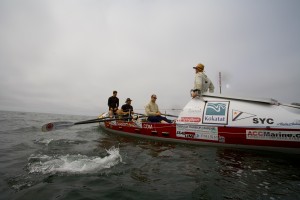
I will let Rick go into detail about seasickness, how to suffer and hopefully prevent it at a later blog. For the sake of narrative it picked up as we left Destruction Island. Nighttime on a small boat is a disorientating experience. Combined with the effects of the first few days of sea the mix, so to speak, can get a stomach churning very quickly. The wind was behind us from the northwest and our speed was a solid four knots. Unfortunately this was too quickly for our tide window to enter Westport. Like most west coast bars this is a dangerous bar, especially in a rowboat, and it’s important to enter with the flood tide. This meant we had to kill time, so we put out the sea anchor. This is a parachute about six feet across that is attached to the bow of our boat. Once this chute is put in the water it arrests the motion of the boat and keeps us from drifting to far. We rigged the chute less correctly that we did on the North Atlantic and although we were not in danger it made for a much more uncomfortable ride as the beam seas rocked our boat and put me on the edge of vomiting. I took the watch, climbing into a survival suit for warmth while Greg and Adam rolled about in the cabin. Rick was now passed out on deck, bundled up with several layers of clothes and wrapped in a blanket. We were easily the 4 most miserable people in at least 5 square miles. In the distance I could see the lights of a fishing vessel that never seemed to move. My eyelids fluttered open and shut to make sure he did not get any closer in spite of my foul weather gear I was getting cold. Not the icy cold of a mountain but a bone chilling cold of 50 degrees and damp. At this point it would be better to row. The good news is that at the rate we had been going we could cover the distance between La Push and Grays Harbor in 20 hours. The bad part was that we had given ourselves 36.
This meant we were quick enough to catch an earlier flood tide into Grey’s Harbor. Throughout the day we watched the coast move slowly from high-forested palisades and sea stacks to low lying beige beach. We were two miles off shore and the waves changed from a favorable northwest direction to large eight to ten foot rollers covered in two-foot wind chop one the beam. Rick was sleeping on deck goring through waves of feeling good followed by dry heaves and miserable. I had woken up from the midday shift feeling very sick myself and Adam kept me company until I felt obligated to stick my finger down my through to pull the trigger and ease the nausea. He didn’t have too much to say to me after that and went inside and proceeded to become nauseous as well. It was nice to know I could still row and vomit at the same time.
As we approached the bar we double-checked lifelines, life vests, battened the hatches and cleared the deck. To the north of the entrance we could see large waves crashing on the rocks. Fishing and commercial boats called in over channel 16 asking the Coast Guard for a bar report. Our boat, in spite of its size is very stable in big and uncomfortable waves. The challenge comes from our lack of power. From a practical and safety standpoint this means that each move we make needs to be the right one because we cannot afford to put ourselves in a position that would require a lot of horse power to get out of. Conversely the lack of speed also provides a lot of time to check, double check and discuss conditions, charts and GPS in order to make the correct decision. It must of worked as Adam and Rick were thoroughly unimpressed with the lack of excitement during the bar crossing. A rough bar crossing is something I’m just never going to wish for, although I do see where they are coming from.
What this trip brought home for me was the importance of the first 48 to 72 hours at sea. I have often described rowing the ocean as a feeling of being drunk and hangover at the same time. After this cruse it became obvious to me how the combination of sweating from working out, lack of sleep combined with nausea make a cocktail of chronic dehydration that ends up taking weeks to get over because of the continued stress on the body. It’s now obvious that this led to the constant hung-over feeling that characterized a lot of my first crossing. By fixing the nausea the rest of the stresses (lack of sleep, rowing) can be managed.
